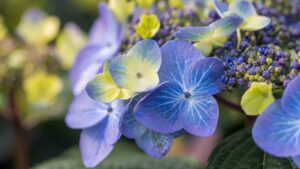You’ve got questions and we’ve got answers! We’re breaking down some of our most commonly asked questions and sharing tips, tricks, and insights into hydrangea care and planting. Let’s get into it!

A: There are a few main reasons that you may not see blooms on your hydrangea bushes: sun exposure, over-watering and over-fertilizing. Endless Summer® hydrangeas prefer morning sun and afternoon dappled shade. If they are planted in full sun, it may be too hot and intense for the blooms to produce.
Also, over-watering and over-fertilizing your plants can inhibit bloom production. Hydrangeas prefer moist, but not wet soil, and one application of fertilizer in spring or early summer. Head to our blog on making your hydrangea bloom to learn even more.
A: If you pruned your hydrangeas back to the base, it will take some time for the new growth to develop and produce blooms.
Be patient and look for the green growth coming up from the base of the plants. That is where your new blooms will grow from. Our blog on seasonal pruning tips dives into this topic on a deeper level. Check it out!
A: The first rule of thumb is to NOT over-fertilize your hydrangea plants. We suggest one application of granular fertilizer in spring or early summer, and then follow package instructions afterwards.
If you over-fertilize, it can burn the root system of your hydrangea bushes and actually inhibit bloom production. We have a blog on understanding fertilizer that will explain this further.
A: If the spot is round and brown with a red to purple ring, you likely have Anthracnose. Remove the affected leaves and dispose away from your plants. Treat with a fungicide and repeat as necessary.
If the margins of the leaves fade from green to grey and then turn brown, the plants were dry for too long. If the petals of the flowers turn brown at the tip, not enough water was applied. Both the leaves and the flowers will show lack of water very quickly.
A: Depending on where in the United States you live will determine how much sun your hydrangeas can handle. If you are in a northern state (Zones 4 – 5b), your hydrangeas can handle up to 6 hours of sun in the morning, but as you get further south you should allow for more shade on your plants.
In the southern-most regions (Zones 8 – 9), we recommend a maximum of 2 hours of morning sun. Too much sun exposure can cause your hydrangea shrubs to burn on its leaves and blooms.
Also, be sure to put your fingers in the soil to see if it needs watering. We do recommend a soak versus light watering each day, but you should be sure that the soil is always moist – not wet – by sticking your fingers in the dirt. If it is dry, give it a good soaking. If it is wet, do not add water.
Check out our blog on watering to brush up on hydrangea water care.
A: Absolutely! Hydrangea shrubs are perfect as potted plants and give you the ability to move the hydrangeas to different locations and create a focal point in your living space. The care instructions are mainly the same, with a few notable differences.
We have lots of container gardening blogs and videos for you to browse through, but we recommend starting with our video on planting hydrangea in containers.
A: We recommend a granular, slow-release fertilizer with a NPK ratio of 10-30-10. If you cannot find that specific ratio, ask your local nursery for a fertilizer with a high concentration of phosphorus, as that encourages the bloom growth.
A: The pH level of your soil determines hydrangea colors. If you have a pink hydrangea and you want a blue hydrangea, no problem!
Pink blooms develop in alkaline soil, so certain amendments need to be made to lower the pH and create an acidic soil situation. To encourage blue blooms in alkaline soils, add aluminum sulfate, composted oak leaves, pine needles or coffee grounds.
A: If you are transplanting your hydrangea bushes, we recommend doing so while it is dormant. That means transplanting your hydrangea shrubs in late fall, after the first frost, or in early spring before it has woken up for the summer. Watch our Garden Gab™ on transplanting hydrangeas to learn more.
A: The great thing about Endless Summer® hydrangeas is that you don’t need to prune them back to the base like other hydrangeas. Since they bloom on previous years’ growth AND the new season’s growth, you can leave them all winter long to achieve double the blooms next spring.
Do NOT prune the hydrangea back in fall. Leaving the fall blooms on your plants over the winter provides winter interest, and ensures you aren’t removing buds that will become flowers in the spring and summer.
Leaves, wood mulch and/or straw are good options to insulate your plants. Mound the mulch or leaves around your plants at least 12” high to protect the flower buds that will bloom early next year.
A: Use our Find a Retailer tool to locate Endless Summer® at garden centers near you. You can also order hydrangeas online during our shipping season.
Have a question that wasn’t covered in this blog? Follow us on social to ask questions, get even more tips and tricks, and enjoy our inspirational content. And remember to sign up for our newsletter for all of this and more delivered to your inbox monthly.